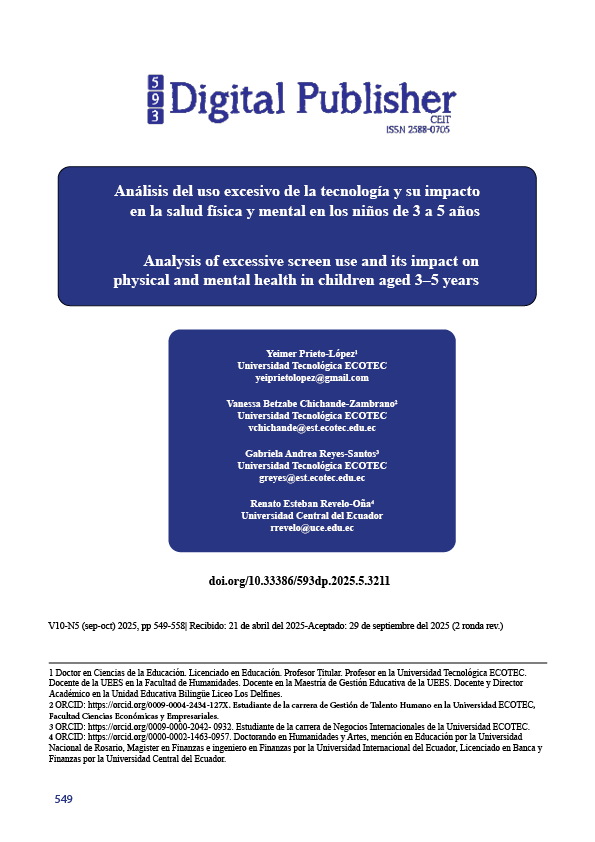Análisis del uso excesivo de la tecnología y su impacto en la salud física y mental en los niños de 3 a 5 años
Contenido principal del artículo
Resumen
La presente investigación analiza el impacto del uso excesivo de la tecnología en la salud física y mental de niños de 3 a 5 años, un grupo etario particularmente vulnerable a los efectos del sedentarismo, la sobreexposición sensorial y la falta de regulación emocional. El estudio se desarrolló bajo un enfoque mixto (cualitativo y cuantitativo), combinando entrevistas semiestructuradas a especialistas, un grupo focal con estudiantes universitarios y una encuesta aplicada a 171 padres de familia del cantón Samborondón, Ecuador. Los resultados revelan que la exposición prolongada a pantallas digitales está asociada con alteraciones en rutinas básicas (sueño, alimentación y actividad física), problemas conductuales y dificultades de socialización. Asimismo, se identificó una supervisión parental limitada y un uso frecuente de dispositivos como recurso de crianza. Sin embargo, también se evidencian oportunidades cuando la tecnología se emplea con fines educativos y bajo acompañamiento adulto. La investigación concluye que es fundamental establecer límites claros y promover actividades lúdicas, físicas y creativas que equilibren el uso tecnológico en la primera infancia. Además, se destaca la necesidad de fortalecer la educación familiar respecto al uso responsable de la tecnología y de diseñar políticas públicas que promuevan entornos digitales saludables. Estos hallazgos aportan evidencia contextual para orientar intervenciones pedagógicas y familiares en el ámbito ecuatoriano.
Descargas
Detalles del artículo

Esta obra está bajo una licencia internacional Creative Commons Atribución-NoComercial-CompartirIgual 4.0.
1. Derechos de autor
Las obras que se publican en 593 Digital Publisher CEIT están sujetas a los siguientes términos:
1.1. 593 Digital Publisher CEIT, conserva los derechos patrimoniales (copyright) de las obras publicadas, favorece y permite la reutilización de las mismas bajo la licencia Licencia Creative Commons 4.0 de Reconocimiento-NoComercial-CompartirIgual 4.0, por lo cual se pueden copiar, usar, difundir, transmitir y exponer públicamente, siempre que:
1.1.a. Se cite la autoría y fuente original de su publicación (revista, editorial, URL).
1.1.b. No se usen para fines comerciales u onerosos.
1.1.c. Se mencione la existencia y especificaciones de esta licencia de uso.
Citas
Aguilera Meza, C. K., Santos Loor, C. P., Pinargote Párraga, B. A., & Erazo Delgado, J. R. (2020). Gamificación: estrategia didáctica motivadora en el proceso de enseñanza aprendizaje del primer grado de educación básica. Revista Cognosis, 5(2). https://doi.org/10.33936/cognosis.v5i3.2083
American Academy of Pediatrics. (2016). Media and young minds. Pediatrics, 138(5), e20162591. https://doi.org/10.1542/peds.2016-2591
Boer, M., Stevens, G. W., Finkenauer, C., de Looze, M. E., & van den Eijnden, R. J. (2020). Social media use intensity, social media use problems, and mental health among adolescents: Investigating directionality and mediating processes. Computers in Human Behavior, 116, 106645. https://doi.org/10.1016/j.chb.2020.106645
Carson, V., Hunter, S., Kuzik, N., Gray, C. E., Poitras, V. J., Chaput, J. P., ... & Tremblay, M. S. (2018). Systematic review of sedentary behaviour and health indicators in school-aged children and youth: An update. Applied Physiology, Nutrition, and Metabolism, 41(6), S240–S265. https://doi.org/10.1139/apnm-2015-0630
Carter, B., Rees, P., Hale, L., Bhattacharjee, D., & Paradkar, M. S. (2016). Association between portable screen-based media device access or use and sleep outcomes: A systematic review and meta-analysis. Sleep Medicine Reviews, 27, 51–68. https://doi.org/10.1016/j.smrv.2015.08.002
Coyne, S. M., Stockdale, L., & Summers, K. (2021). Parenting, media, and children’s screen time: A longitudinal study. Journal of Family Psychology, 35(2), 255–266. https://doi.org/10.1037/fam0000775
Creswell, J. W., & Plano Clark, V. L. (2018). Designing and conducting mixed methods research (3rd ed.). SAGE.
Domoff, S. E., Radesky, J. S., Harrison, K., Riley, H., Lumeng, J. C., & Miller, A. L. (2019). A naturalistic study of child and family screen media and mobile device use. Journal of Child and Family Studies, 28, 401–410. https://doi.org/10.1007/s10826-018-1275-1
Gómez, S., Perazzo, M. F., & González, M. (2022). Children’s digital media use during the COVID-19 pandemic in Latin America. International Journal of Child-Computer Interaction, 32, 100434. https://doi.org/10.1016/j.ijcci.2021.100434
Hinkley, T., Salmon, J., Okely, A. D., Crawford, D., & Hesketh, K. (2019). Preschoolers’ physical activity, screen time, and compliance with recommendations. Medicine & Science in Sports & Exercise, 51(7), 1468–1474. https://doi.org/10.1249/MSS.0000000000001900
Hutton, J. S., Dudley, J., Horowitz-Kraus, T., DeWitt, T., & Holland, S. K. (2020). Associations between screen-based media use and brain white matter integrity in preschool-aged children. JAMA Pediatrics, 174(1), e193869. https://doi.org/10.1001/jamapediatrics.2019.3869
Jaramillo Parra, F. E. (2024). El impacto de las TIC en la creatividad visual en infantes de preescolar: una revisión sistemática. Ciencia y Educación, 1–16. https://cienciayeducacion.com/index.php/journal/article/view/zenodo.14232778
Madigan, S., Browne, D., Racine, N., Mori, C., & Tough, S. (2019). Association between screen time and children’s performance on a developmental screening test. JAMA Pediatrics, 173(3), 244–250. https://doi.org/10.1001/jamapediatrics.2018.5056
Narváez León, I. E., & Fárez Loja, D. E. (2022). Estrategias didácticas para favorecer el proceso de aprendizaje en niños de 3 a 4 años. Revista SCIELO, 5(10), 1–23. https://ve.scielo.org/scielo.php?pid=S2665-02822022000200078&script=sci_arttext
Nikken, P., & Opree, S. J. (2018). Guiding young children’s internet use at home: Problems, strategies, and relation with parental attitudes. Journal of Child and Family Studies, 27(5), 1629–1641. https://doi.org/10.1007/s10826-017-0983-8
Orben, A., Tomova, L., & Blakemore, S. J. (2020). The effects of social deprivation on adolescent development and mental health. The Lancet Child & Adolescent Health, 4(8), 634–640. https://doi.org/10.1016/S2352-4642(20)30186-3
Radesky, J. S., Schumacher, J., & Zuckerman, B. (2016). Mobile and interactive media use by young children: The good, the bad, and the unknown. Pediatrics, 135(1), 1–3. https://doi.org/10.1542/peds.2014-2251
Strauss, A., & Corbin, J. (1998). Basics of qualitative research: Techniques and procedures for developing grounded theory (2nd ed.). SAGE.
Tremblay, M. S., LeBlanc, A. G., Janssen, I., Kho, M. E., Hicks, A., Murumets, K., ... & Duggan, M. (2017). Canadian sedentary behaviour guidelines for children and youth. Applied Physiology, Nutrition, and Metabolism, 36(1), 59–64. https://doi.org/10.1139/H11-012
Twenge, J. M., & Campbell, W. K. (2018). Associations between screen time and lower psychological well-being among children and adolescents: Evidence from a population-based study. Preventive Medicine Reports, 12, 271–283. https://doi.org/10.1016/j.pmedr.2018.10.003
WHO. (2019). Guidelines on physical activity, sedentary behaviour and sleep for children under 5 years of age. World Health Organization. https://www.who.int/publications/i/item/9789241550536
Wu, P. C., Huang, H. M., Yu, H. J., Fang, P. C., Chen, C. T., & Chen, C. H. (2022). Effects of screen time on visual function in preschool children. Journal of Ophthalmology, 2022, 1–8. https://doi.org/10.1155/2022/4515045





